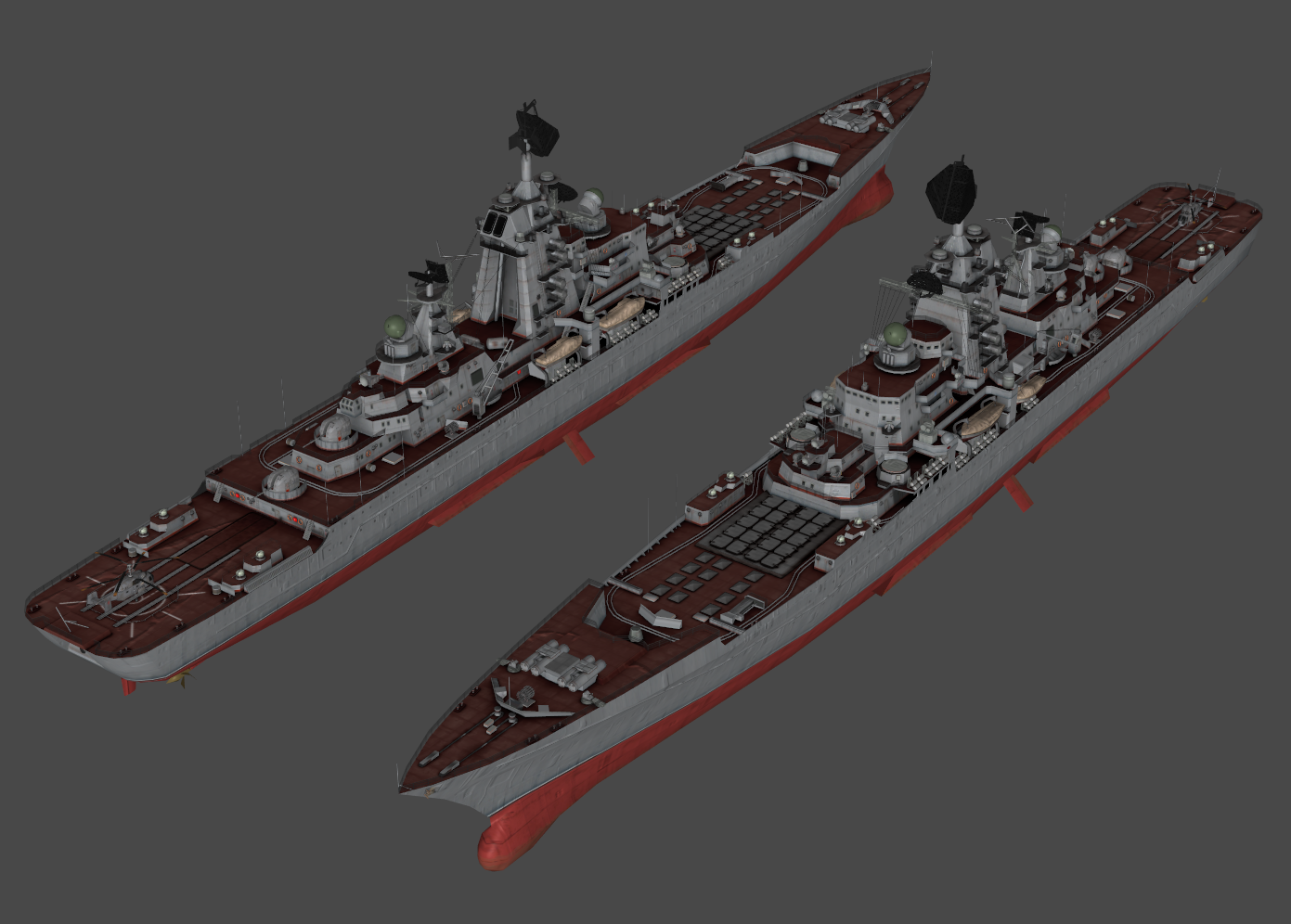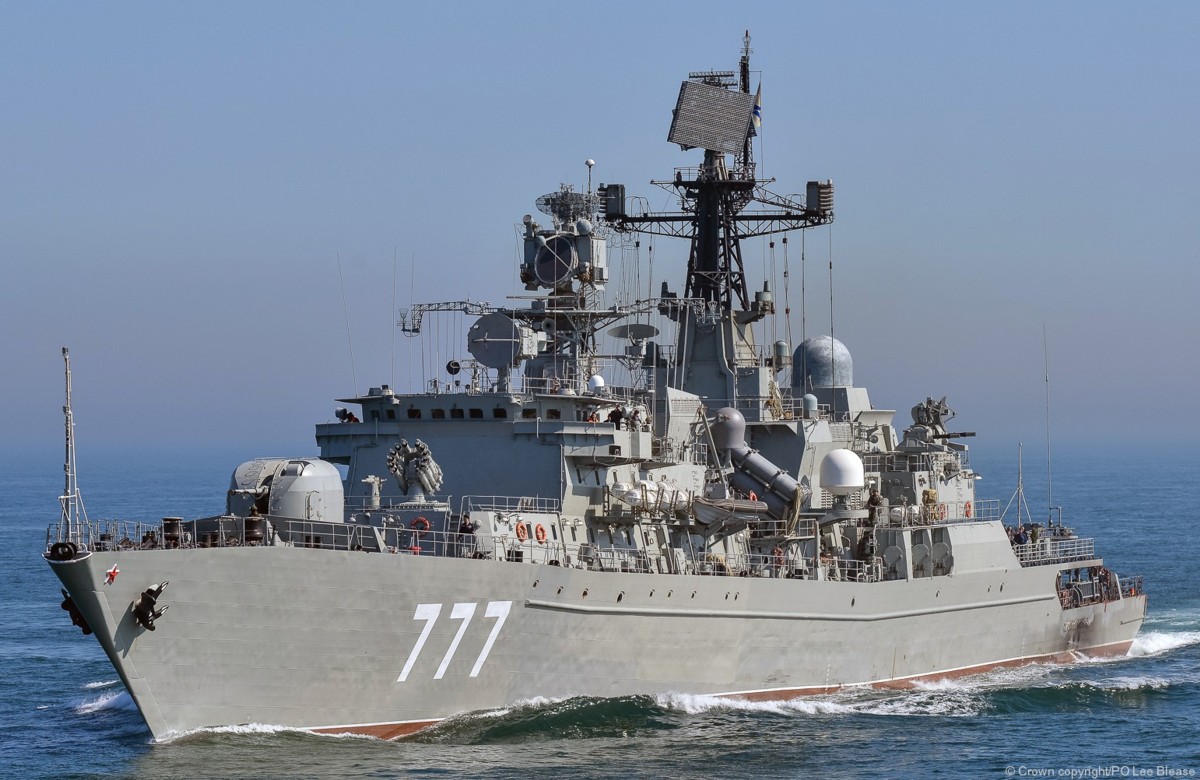Russian Ship Kirov - The Grove is the flagship of the Grove class of nuclear-powered guided missile cruisers. Originally built for the Soviet Navy and later transferred to the Russian Navy, she and her three sister ships were the largest and heaviest surface ships (ie, not an aircraft carrier or amphibious assault ship) ever built. The Soviet classification for the ship's type is "heavy nuclear-powered guided missile cruiser" (Russian: тяжёлый атомный ракетный кризер), but the Kirov's size and array of weapons have earned her an unofficial designation worldwide. Size and displacement similar to a typical WWI battleship. The appearance of the Grove class was a major factor in the re-commissioning of the Iowa class by the US Navy.
She was launched on 27 March 1974 at the Baltisky Naval Shipyard in Leningrad, commissioned on 26 December 1977 and commissioned on 30 December 1980 as part of the Soviet Northern Fleet.
Russian Ship Kirov

When she first appeared in 1981, NATO observers named her BALCOM I (Baltic Combatant I). His first major deployment was in 1984 when he went on a trip to the Mediterranean.
Russia Threatens Retaliation If Ukraine Demands Not Met
On her second major deployment to the Mediterranean from 1 December 1989 to 17 February 1990, she suffered a reactor accident. After that he was kept in custody. Due to lack of funds and the changing political situation in the USSR, repairs were never carried out. She can also be cannibalized as a spare parts cache for other ships of her class.
For political reasons, Kirov was renamed Admiral Ushakov in 1992, after the 18th-century Admiral Fyodor Fyodorovich Ushakov, but the following photographs suggest that it retained its original name. Major repairs began in 1999, but the ship was decommissioned in 2001 and scheduled for scrapping in 2003.
In June 2004, Admiral Ushakov was renamed the Sovremny-class destroyer Besstrashny. In September 2004, it became known that the Severodvinsk-based design bureau Onega was commissioned to develop a plan to dismantle a cruiser docked at the Severodvinsk Zvezdochka plant. According to the Zvezdochka plant, the removal of the ex-admiral Ushako will cost $40 million.
In 2010, the Russian Navy again announced new plans to replace the ship. At that time, the plan was to replace and reactivate all Grove battlecruisers by 2020.
Slava Class Cruiser
However, in 2012 it was announced that Admiral Ushakov and Admiral Lazarev would not undergo major modifications as they were "irreparable".
In 2015, Zvezdochka Shipyard CEO Vladimir Nikitin said removing spt nuclear fuel from the ship's two reactors was dangerous because the ship had been stored for at least 34 years.
The ship was carrying a large number of missiles and weapons and electronics. Its massive radar antenna is mounted on its forward mast, and NATO calls it the "Top Name". The Kiro's main armament is 20 deck-mounted P-700 Granit (SS-N-19 Shipwreck) missiles, designed to engage large targets, and air defenses are equipped with 12 S-300F (SA-N-6 Grumble) launchers. 96 missiles, two Osa-M (SA-N-4 Gecko) 40 missiles and Kashtan CIWS (CADS-N-1) anti-aircraft missile/weapon system.

Other armaments include an automatic 130mm AK-130 gun system, 30mm AK-630, 10 torpedo/rocket tubes, 40 Ast-1 (SS-N-14 Silux) anti-submarine missiles and two RPU-1000 six. -tube launchers.One of Russia's giant warships ready for battle: Could Russia's two existing battlecruisers join the fight against Ukraine? Grove-class battlecruisers are among the world's largest warships, excluding aircraft carriers. An 827-foot vessel is still undergoing repairs at the shipyard and is in disrepair. But another nuclear-powered ship has completed exercises in the Barents Sea and is an asset the Russians are choosing to send to the Black Sea for operations off the coast of Ukraine.
Russia's 24,000 Ton Battlecruisers: Just A Giant Target In A War?
So far, open-source intelligence research has found no reports of the Kirov-class battlecruiser Pyotr Veliki in the Black Sea for Ukrainian theater operations. As of March 22, the Russian Navy is said to have 21 ships in the Black Sea. Among them 12 are surface ships and nine are amphibious ships. The Moskva, one of the Slava-class missile cruisers, is in the Black Sea and is believed to be the largest ship operating near Ukraine.
Pyotr Veliki of the Northern Fleet completed exercises in the Barents Sea last month. Another Kirov-class frigate—the Cold War-era Admiral Nakhimov—is suitable for weapons upgrades and nuclear refueling. The Russian Navy has big plans for the 35-year-old Admiral Nakimov at the Sevmash shipyard in Severodvinsk. The billion-dollar overhaul includes new missiles, a close-in weapons system, new electronics, anti-submarine munitions, long-range surface-to-air missiles and hypersonic missiles.
Admiral Nakhimov will receive modern Fort M missiles for the ship's S-300FM SAM system. The S-300FM can hit up to six targets simultaneously and is effective against anti-ship missiles up to 93 miles away. The battlecruiser may also eventually receive the S-400 SAM system.
Nakhimov already has Oniks anti-ship cruise missiles and Kalibr surface attack cruise missiles. The Zircon hypersonic missile may make a cameo on the ship at some point. The 28,000-ton vessel also has three helicopters.
Could America's Best Battleship Beat The Soviet Kirov Class Battlecruiser?
Port view of the Soviet nuclear-powered guided missile cruiser KIROV at anchor. In the background is a Soviet Grivak I class guided missile frigate.
But not so fast. Nakhimov, like many ships in service at Russian naval shipyards, has endured schedule slippage and will not be completed until next year.
"The main problem with Admiral Nakhimov and all ships of the Arlan project - four built, two of which are retired - are nuclear-powered engines that use highly enriched uranium," naval analyst Pavel Luzin told Forbes. . . Lucin also explained how engine technology has become outdated since the 1980s. "In short, these machines cause a lot of problems," Lucin said. "This is why Russia has been able to maintain only one ship, the Pyotr Veliki, since the late 1990s."

Meanwhile, Nakhimov's sister ship, Pyotr the Great, will require a similar transfer while Nakhimov is in the docks. So the Russians don't operate both warships at the same time. This hurts overall readiness and keeps significant combat power on the bench.
Russian Navy Kirov Class Heavy Nuclear Missile Cruiser Pyotr Veliky 2017 Complete Upgrade Set (for Trumpeter 05710)
Pyotr Velikiy will carry the ball until Nakhimov is freed to work. It is not clear whether the warship will go to the Black Sea, but its capabilities are welcome in that area of operations. Velikiy must also defend against enemy aircraft carriers. Harry S. The Truman Aircraft Carrier Strike Group conducted exercises in the Mediterranean last month with the French aircraft carrier Charles de Gaulle and the Italian aircraft carrier Cavour.
. He is an emerging threat expert and former US Army infantry officer. You can follow him on Twitter
Currently serving as the 1945 New Defense and National Security Editor, Dr. Brent M. Eastwood is the author of Humans, Machines, and Data: Future Trends in Warfare. He specializes in emerging threats and is a former US Army infantry officer. Russia's Kirov-class warships: Some of the largest warships in the Russian Navy - Russia's Kirov-class warships are likely to see significant service as Russia's remaining warships are still in service. Life ahead of them. Among them. These two remaining examples,
However, the modernization and restructuring issues of both have thrown the future of the class into doubt.
Kirov Class Battlecruisers: Peter The Great(183) And Kirov(090). Also A Lot Of Other Warships Could Be Seen. [1704*1188]
Designed in the twilight years of the Cold War, when the Soviet Navy expected to fight American carrier groups, the Kirov-class ships were somewhat out of place after the collapse of the Soviet Union. Russia's successor has few resources to devote to a large fleet of nuclear-powered missile cruisers like the Kirovs.
In the decades since the fall of the Soviet Union, Russian naval leadership has scaled back competing plans to scrap or rebuild two other Kirov-class ships:
. Despite some early signs that both will be refitted, Moscow appears to be too burdened to maintain them, with the Russian Navy announcing in 2019 that it plans to cancel the modernization and life extension of the two ships and begin decommissioning them. The year is 2021.

(named after Peter the Great), an active participant in Russian naval exercises. Back in March,
Aerial Port Bow View Of The Soviet Kirov Class Nuclear Powered Guided Missile Cruiser Frunze Underway
Norwegian participated in exercises at sea, where the use of surface-to-air missiles was practiced and NATO cold response exercises were covered.
The first of the 2000 exercises was the accidental sinking of the Russian nuclear submarine Kursk.
Both ships are massive, largely a function of their respective large missile armaments. In terms of air weapons, the Kirov-class ships can carry 96 S-300F, 40 4K33 and 192 3K95 short-range air-to-air missiles, as well as six AK-630 close-in defense systems. However, the Kiro's primary weapon is an arsenal of 20 P-700 Granit anti-ship missiles, each weighing more than 15,000 pounds.
S
Ussr Battlecruiser Kirov Class (trumpeter)
Russian kirov, russian war ship, russian ballet kirov, kirov ship russia, kirov ship, russian cruiser kirov, russian icebreaker ship, russian kirov class, russian battlecruiser kirov, russian ship, russian cruise ship, russian ballet company kirov
0 Comments